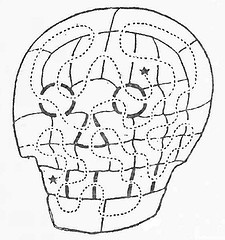
The “Death’s-head Dungeon,” from Henry Dudeney’s Canterbury Puzzles (1908), in which a youth rescues a noble demoiselle from a dungeon belong to his father’s greatest enemy:
“… Sir Hugh then produced a plan of the thirty-five cells in the dungeon and asked his companions to discover the particular cell that the demoiselle occupied. He said that if you started at one of the outside cells and passed through every doorway once, and once only, you were bound to end at the cell that was sought. Can you find the cell? Unless you start at the correct outside cell it is impossible to pass through all the doorways once, and once only.”
|
SelectClick for Answer |

“‘Some here have asked me,’ continued Sir Hugh, ‘how they may find the cell in the dungeon of the Death’s Head wherein the noble maiden was cast. Beshrew me! but ’tis easy withal when you do but know how to do it. In attempting to pass through every door once, and never more, you must take heed that every cell hath two doors or four, which be even numbers, except two cells, which have but three. Now, certes, you cannot go in and out of any place, passing through all the doors once and no more, if the number of doors be an odd number. But as there be but two such odd cells, yet may we, by beginning at the one and ending at the other, so make our journey in many ways with success. I pray you, albeit, to mark that only one of these odd cells lieth on the outside of the dungeon, so we must perforce start therefrom. Marry, then, my masters, the noble demoiselle must needs have been waiting in the other.’
“The drawing makes this quite clear to the reader. The two ‘odd cells’ are indicated by the stars, and one of the many routes that will solve the puzzle is shown by the dotted line. It is perfectly certain that you must start at the lower star and end at the upper one; therefore, the cell with the star situated over the left eye must be the one sought.”
|


